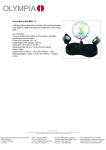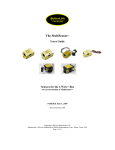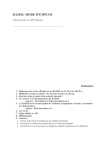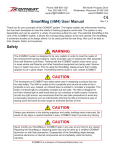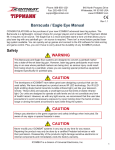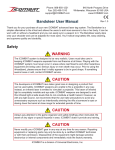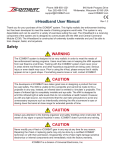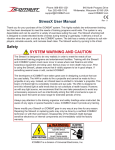Download LinkLocator manual
Transcript
LinkLocator™ User’s Manual Model 1 shown with MBL Touch probe and fobs 5-Mar-14 iButton®Link LLC 1221 Innovation Drive, Suite #117 Whitewater, WI 53190 http://www.iButton®Link.com Copyright © 2005,2014, iButtonLink LLC. All rights reserved 3/5/2014 8:29 PM Page 1 Modification History: Date 15-JUN-2005 5-MAR-2014 Revisions Initial Version Update to include notes on Model 4 and examples of extended mode commands. Copyright © 2005,2014, iButtonLink LLC. All rights reserved 3/5/2014 8:29 PM Page 2 General The LinkLocator™ is a breakthrough product that allows a 1-Wire® integrator to quickly and reliably determine which read head was used to attach an iButton® to the 1-Wire™ bus. This location feature is one of the most sought after features in 1-Wire®. While 1Wire® provides a low-cost, reliable, networked solution for electronic keys, guard tour,and other applications, there has never been a simple way to determine which reader the iButton® user is using. Previous attempts to solve this deficiency have included schemes using switches to switch the iButton® read head on and off the bus so that the location can be implied by the state of the switch. This approach, while workable for small numbers of probe heads, introduces switching noise, settling times, and reduced noise immunity for the overall bus. The LinkLocator™ uses no switches. Its approach to location is to monitor the bus traffic and add additional information to the 1-wire data stream during a search or Alarm Search ROM command. LinkLocator™ can be used with any iButton® probe head. Simply wire the LinkLocator™ between the probe head and the 1-wire bus. Multiple LinkLocator™ scan reside on the same bus. The 1-wire behind the LinkLocator™ must be kept short, a maximum length of 1.5 meters is recommended. Several models of the LinkLocator™ include additional functionality. The Model 1 LinkLocator™ is designed for use in retrofit applications. The Model 2 is an end user package with dual RJ45 connectors. The Model 2 is intended for proof of concept evaluations. The Model 3 (iButton®LinkReader™) is designed for new installations and is packaged to minimize installation costs. LinkLocator™ technology is also available for OEM’s as a chip level product for inclusion in the OEM’s product. The chip level product is available in 8-pin DIP and SOIC-150 packages. Chip level products are available only under NDA and purchase minimums apply. Chip level products are available as PB free parts for OEM’s designing for the EU market. Copyright © 2005,2014, iButtonLink LLC. All rights reserved 3/5/2014 8:29 PM Page 3 Software Programming: Locate Mode: Locate Mode happens completely within the NORMAL OW protocol mode. Normal protocol mode is selected by the \O Link Master Command. This is the default operating mode of LinkLocator™s and is the power up mode. The LinkLocator™ monitors the 1-wire® ROM search (0xF0) or ROM alarm search (0xE0). If the selected 1-wire device is down stream of the LinkLocator™, the LinkLocator™ becomes selected. The LinkLocator™ then monitors for a 0x00 byte coming down the bus. Receipt of this byte arms the LinkLocator™. The LinkLocator™ will respond with its serial number bytes to the next 8 byte reads that are issued by the 1-wire master. Please note: The 1-wire device selected with the search is NO LONGER SELECTED. The 0x00 byte caused the 1-wire slave to deselect. Example using Link45 ASCII commands: \F is the locator first command. It will search the 1-wire network for the lowest 1-wire serial number and return it along with the serial number of the locator associated with it. The Link45 response is of the form Sxxxxxxxxxxxxxxxx,yyyyyyyyyyyyyyyy Where: S indicates the status of the 1-wire search. The possible values of S are: + … This is not the last 1-wire device on the network. (There were discrepancies during the search. - … This is the last 1-wire slave address on the network. (No discrepancies noted) E … An error occurred during the search. The search results are invalid. N ... No slaves were present on the 1-wire network (No presence) xxxxxxxxxxxxxxxx is the serial number of the 1-wire slave discovered Copyright © 2005,2014, iButtonLink LLC. All rights reserved 3/5/2014 8:29 PM Page 4 yyyyyyyyyyyyyyyy is the serial number of the LinkLocator™ associated with xxxxxxxxxxxxxxxx If the 1-wire slave was NOT downstream of a LinkLocator™, the Locator serial number will be FFFFFFFFFFFFFFFF. Extended Mode: Extended Mode is used to command and search LinkLocator™s. Please note that 1-wire slaves from Dallas-Maxim do NOT participate in Extended Mode. A special command sequence is sent by the Link Master to cause ALL Dallas-Maxim parts to ignore the bus so that only eXtended mode slaves will participate. LinkLocator™s use FxB communications during eXtended mode, so there is no conflict with the Dallas-Maxim parts. Extended Mode is entered by issuing the \X command. LinkLocator™ responds to the following ROM commands when in Extended Mode: Commands common to all eXtended Mode Slaves: Search ROM (0xF0) Alarm Search ROM (0xE0) Skip ROM (0xCC) Read ROM (0x33) Match ROM (0x55) Commands specific to the LinkLocator™ Green LED on (0x12) Red LED on (0x13) LED’s off (0x14) Report Software Version (0x01) Read one additional byte after the 0x01 command. The major software version will be in the high nibble, the minor software version will be in the low nibble. The current version of LinkLocator™ returns 0x10 (Version 1.0) The Family code of LinkLocator™ is 0xFE. The serial number format is exactly the same as Normal Mode. Example: The user wishes to produce an inventory of all LinkLocator™s on the bus. \X ... Specify eXtended mode. The Link45 will respond X<CR><LF> f ... The Link45 will respond ... Copyright © 2005,2014, iButtonLink LLC. All rights reserved 3/5/2014 8:29 PM Page 5 Syyyyyyyyyyyyyyyy<CR><LF> Where: S is the status of the search. Possible values are +,-,N,E yyyyyyyyyyyyyyyy Serial Number of the first LinkLocator™ on the eXtended Bus. Then the programmer will issue next commands (n) retrieving the serial number of each of the LinkLocator™s until the Status character is – (indicating that the search is complete). Executing Extended Mode Commands Note: In extended mode the binary mode commands must be sent before a timeout in the LinkLocator™ expires. It is nearly impossible to hand type the command at the correct speed. The best methods to send the command are a) through a program or b) by entering the command into Notepad and then using a copy and paste to enter the entire string at one time. Note: An extended mode binary command will only work if it directly follows a reset. How to check the version number of a LinkLocator™ This example assumes that the LinkLocator™ is the only item on the bus so that the Skip ROM Command (0xCC) may be used to select the LinkLocator™. 1. Enter extended mode Command \X Response X<CR><LF> 2. Reset the 1-Wire bus Command r Response PFE 3. Send the command to read the status. This is a binary mode command. Copyright © 2005,2014, iButtonLink LLC. All rights reserved 3/5/2014 8:29 PM Page 6 Command bCC01FF Response bCC0110 The above command consists of the following parts: b: Enter binary mode CC: Skip ROM Command – this command selects all slaves on the bus. 01: Command byte 01 is sent to all slaves on the bus FF: This dummy byte is modified by the slaves when data is transmitted to the host. In the above command the 0xFF sent to the LinkLocator™ was modified to a 0x10 to indicate the LinkLocator™ version number of 0x10. How to turn an LED pin on or off on a LinkLocator™ Some models of LinkLocator™ have built in LEDs. Some models may have LEDs added to them. The following instructions apply to models where an LED exists. These commands may also be used to toggle IO pins in the Model 4 LinkLocator™. The IO pins are inside the sealed box. For an OEM product, this could be used as a low level signal to activate relays that activate a door lock or light an indicator. This example uses 0000000000000000 as the LinkLocator™ 1-Wire serial number. Please adjust your command to use the correct LinkLocator™ serial number.. 1. Enter extended mode Command \X Response X<CR><LF> 2. Reset the 1-Wire bus Command r Response PFE 3. Send the command to read the status. This is a binary mode command. Turn on Red LED: Command b55000000000000000012FF Response b55000000000000000012FF Turn on Green LED: Command Response Copyright © 2005,2014, iButtonLink LLC. All rights reserved 3/5/2014 8:29 PM Page 7 b55000000000000000013FF b55000000000000000013FF Turn off both LEDs: Command b55000000000000000014FF Response b55000000000000000014FF The above command consists of the following parts: b: Enter binary mode 550000000000000000: Match ROM Command – this command selects one slave on the bus that has an address of 0000000000000000. 12,13, or 14: Command byte that is sent to the specific LinkLocator™ FF: This dummy byte is modified by the slaves when data is transmitted to the host. In the above command the 0xFF sent to the LinkLocator™ is not changed by the LinkLocator™. Copyright © 2005,2014, iButtonLink LLC. All rights reserved 3/5/2014 8:29 PM Page 8 Model and Wiring Information: Four models of the LinkLocator™ have existed. Two models currently are available. Model 1: The LinkLocator™ Model 1 is supplied as an encapsulated (potted) package cylinder shaped. The dimensions are 0.5 inch diameter, 1.5 inch length. The hookup wires exit the cylinder on one end. This package is great for OEM applications. The Model 1 may be integrated with the users probe head. It fits in the MBL Technologies Touch Reader available separately. The Model 1 is shown inside a MBL Technologies WeatherTight Enclosure. The Model 1 is appropriate for retrofit applications. The wire designations are: Orange (+5V) (optional but recommended) Blue ... Master bus 1-wire Yellow ... Located bus 1-wire Black ... Ground Black ... Ground Green ... To BiColor LED on MBL Touch Reader Brown ... To BiColor LED on MBL Touch Reader Copyright © 2005,2014, iButtonLink LLC. All rights reserved 3/5/2014 8:29 PM Page 9 Model 2: Note: This model is deprecated. The LinkLocator™ Model 2 is supplied as a packaged unit with enclosure box, MBL touch reader, and embedded LinkLocator™. The 1-wire network connections are RJ45. This is an end user package intended for proof of concept testing. Indoor use only. Copyright © 2005,2014, iButtonLink LLC. All rights reserved 3/5/2014 8:29 PM Page 10 Model 3 (Also known as the iButton®LinkReader™) Note: This model is deprecated. The Model 3 (iButton®LinkReader™) is a tight integration of the LinkLocator™ and the MBL touch reader. The LinkLocator™ is implemented as a “little round board” attached to the pins on the back of the MBL Touch Reader. This model is designed for new installations. It is designed to optimize installation costs. The Model 3 is supplied with 24 inch pig tail connection wires. Blue – 1-Wire communications Black – Ground Orange – Optional (Recommended) +5V DC Note: For outdoor use, we recommend using the Model 3 with the MBL Weather Tight enclosure. The hole recommended for the iButton®LinkReader is a 20mm “Double D”. Copyright © 2005,2014, iButtonLink LLC. All rights reserved 3/5/2014 8:29 PM Page 11 Model 4 The Model 4 provides LinkLocator™ technology in an easy to use MS style case with an RJ-12 jack for an external iButton® read head. This package provides ease of use and flexibility for iButton® read applications. The RJ-12 jack has the following pin-out: Pin 1 2 3 4 Signal No Connection 1-Wire™ Ground AUX line from Link The Model 4 does not expose any LED signals. Internally, the LED signals affect the test points in the following ways: Powerup state: T1:High, T2:Low,T3:High,T4:High 0x12: Red LED ON: T1:Low, T2:Low,T3:High,T4:High 013: Green LED On: T1:High, T2:Low,T3:High,T4:Low 0x14: Turn off LEDs: T1:High, T2:Low,T3:High,T4:High (this is the same as power up) All of the test pins T1-T4 are connected to the microprocessor via a 470 Ohm resistor. The 1-Wire +5 supply should be used for the positive side of an LED, if used with the internal connections. 1-Wire +5 is available in the round test point between J2 and T4. Copyright © 2005,2014, iButtonLink LLC. All rights reserved 3/5/2014 8:29 PM Page 12 Disclaimers: USE OF iButton®Link PRODUCTS IN MEDICAL AND AIRCRAFT OR OTHER TRANSPORTATION SYSTEMS. iButton®Link Products are not authorized for use in, or in connection with Surgical implants, or as critical components in any medical, or aircraft, or other transportation devices or systems where failure to perform can reasonably be expected to cause significant injury to the user, without the express written approval of an Executive Office of iButton®Link. Such use is at Buyer's sole risk, and Buyer is responsible for verification and validation of the suitability of Products incorporated in any such devices or systems. Buyer agrees that iButton®Link is not liable, in whole or in part, for any claim or damage arising from such use and shall have no obligation to warranty such Products. Buyer agrees to indemnify, defend and hold iButton®Link harmless from and against any and all claims, damages losses, costs, expenses and liabilities arising out of or in connection with Buyer's use of iButton®Link Products in such applications to the extent Buyer has not obtained the express written approval of an Executive Officer of iButton®Link. COMPLIANCE WITH U.S. EXPORT REGULATIONS. iButton®Link Products (including samples) are subject to the export control laws and regulations of the United States and to the laws and regulations of the country in which the Products are received. Products may not be sold, leased or otherwise transferred to restricted end-users or countries. Buyer hereby agrees to comply with all applicable export control laws and regulations and will not use or export iButton®Link Products, directly or indirectly, in violation of these laws. Copyrights: As used in this document 1-wire and iButton® are the registered trademarks of Maxim Computer Products. FxB is the trademark of Alicit Software Engineering, LLC LinkLocator™ and iButton®LinkReader are the trademarks of iButton®Link LLC. Copyright © 2005,2014, iButtonLink LLC. All rights reserved 3/5/2014 8:29 PM Page 13













